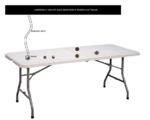mowpsi
Newbie level 1

I'm a computer engineer. I don't have any experiences in electronics and tring to find an anser to the question:
Is it possible to generate magnetic waves to move a metal (very light metal - max 1-2gr)? I drawed the hardware which i want on the following picture:magnetic waves move metals

I have to enter the coordinations of a metal on table in Hardware X and Hardware X should move the given metal to left or right. The distance between the metal elemnt and Hardware X is minimum 1 meter.
So where to start?
Is it possible to generate magnetic waves to move a metal (very light metal - max 1-2gr)? I drawed the hardware which i want on the following picture:magnetic waves move metals

I have to enter the coordinations of a metal on table in Hardware X and Hardware X should move the given metal to left or right. The distance between the metal elemnt and Hardware X is minimum 1 meter.
So where to start?




